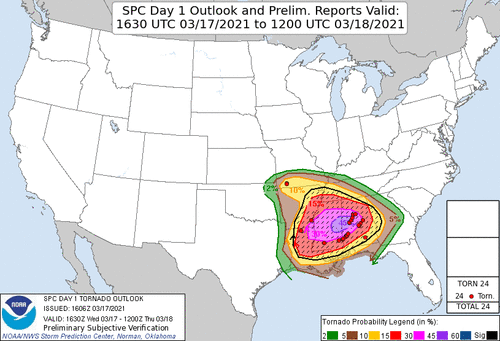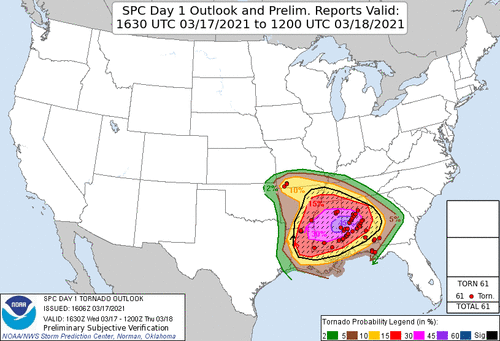Ethan mentioned about Mon morning quarter-backing, I don't think that's the case really. I see it as a opportunity so long as its not filled with "I told you so's", no body likes that. it's a lessons learned kind of thing and post analysis is as good as Pre. I would tend to agree that Lapse Rates, an over abundance of mixed modes, and especially coverage over a large area, messed around with some laminar flow in some spots, while in others it was probably overturning, lack of abundant insolation and atmospheric reset. Obviously in some locations, where those ingredients aforementioned were lessened, the better storms happened. Did the SPC over do it? well its probabilities driven so no initially, but by the morning of day 2? maybe a bit ( more to follow about chart evolution). All in all, I think the timing thing was one problem, another issue was the cold air damming and latent convective cloud cover that was still present on day 2 ( yesterday ), over much of SC and NC which because of the timing of the system the previous day, and slower clearing and over abundance of moisture cooled air, screwed up much of their Day 2 forecast and as you probably noticed they down trended the severities during their updates. it took til about 18-20Z before most of SC/NC cleared out and started to warm up enough for things to pop and when they did, it was almost exclusively on the retrograding warm front.
I was comparing Apr27th2011 to this system, just for S&G's, and I'll keep it short because we could dissect this to a much larger convo haha, but even just a quick look at the upper air, and radar analysis, you can see a vast difference, basically non-existent, in amount of convection present prior to the main event which I think in part was spurred on by the track of the 500mb low and probably a stronger CIN region ahead of the sfc boundary ovr MS/AL. Now, I didn't compare Skew-T's, but I am sure some parallels could be made as will all major systems. So yeah, poor Lapse rates, little to no CIN , timing fluctuations, multiple rounds of convection , no diurnal reset, were possibly the driving factors in quashing a SPC Probabilities driven forecast in this instance.
Apr27th 2011 SPC's Day 1 :
SPC Severe Weather Event Review for Wednesday April 27, 2011
there is verification built in there as well.. some interesting stuff to go back in on and learn from.
Chart Evolution... I wonder 2 things( and I am also guessing here so Im not speaking from experience or personal knowledge)... SPC forecasters over the years, I got to the point where I knew the forecasters who always did the charts, they probably had been there doing the job for 20plus years and used to a certain way of doing things ( Thompson, Rogers, Cohen Daniels, Racy ) are just a few.. but I had wondered if maybe some changed or CAMS modeling is now more a part of the process to create operational products?.. in one instance recently.. this past week, Severe was forecasted for OK/AR/KS in a small area, but I was looking at the past charts forecasted for the same day, just to see what had changed or remained consistent. Over Iowa Minnesota, 2 days prior they were just inside a general area, on the day of, they were inside an enhanced area. now I'm not calling them out, things change as models do to, but it just made me think , about , but it seems like more so recently, there have been more instances of seeing things change a bit more drastically than in other times so it just made me wonder if new folks have replaced legacy older ones?, different methods of production are being done. some of you probably have a better idea than I.


